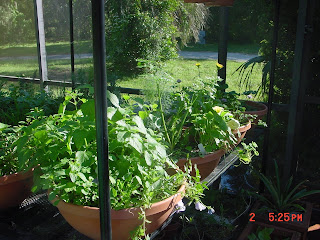When Richard took me to meet his family the first time, his mom made fabulous stuffed artichokes. Unfortunately, I had never seen whole artichokes before and I had no idea how to eat them...it took me forever to eat the leaves and Richard dutifully scraped the choke off the heart for me. I was so wrapped up in my eating challenge, I failed to notice the rest of the family had finished eating much earlier than me and they were all patiently waiting for me to finish so they could have dessert. I'm happy to say, I not only learned how to eat them, but also how to grow and cook them.
Artichokes grow well in frost-free regions when daytime temperatures range between 70 and 75 degrees Fahrenheit and night time temperatures range from 50 – 55 degrees Fahrenheit. Warm climate gardeners have success with 'Green Globe'. Plant early in spring after the last frost as high temperatures sometimes cause artichokes to open their buds prematurely.
Colder regions might fare better with 'Imperial Star'.
Artichokes grow to 5 feet tall and 6 feet wide. Select a planting site where they will not shade out smaller plants. Artichoke plants produce for about five years so select a spot where they do not have to be moved each season.
Artichokes grow well in sandy loam. Add about 6 inches of compost to poor soil to improve drainage before planting. Bury the roots shallowly, 2 to 3 feet apart. Keep the soil moist, but never soggy throughout the growing season. Enrich the soil with composted manure and green sand to ensure adequate supplies of nitrogen and potassium throughout the growing season.
If growing in containers, plant artichokes in containers a minimum of 20 inches deep by 36 inches wide. Containers should have at least 4 drainage holes. Add at least 1/4 inch of gravel to the bottom of the container to facilitate good drainage.
Artichokes do not grow true to their variety from seed. For reliable results, plant artichokes from root sections of your desired variety.
Harvest artichokes when they have reached their full size, but the leaves are still tight.
Cut back the plants to ground level after harvesting. Cover them with a thick layer of straw for winter protection.
Artichokes grow well in frost-free regions when daytime temperatures range between 70 and 75 degrees Fahrenheit and night time temperatures range from 50 – 55 degrees Fahrenheit. Warm climate gardeners have success with 'Green Globe'. Plant early in spring after the last frost as high temperatures sometimes cause artichokes to open their buds prematurely.
Colder regions might fare better with 'Imperial Star'.
Artichokes grow to 5 feet tall and 6 feet wide. Select a planting site where they will not shade out smaller plants. Artichoke plants produce for about five years so select a spot where they do not have to be moved each season.
Artichokes grow well in sandy loam. Add about 6 inches of compost to poor soil to improve drainage before planting. Bury the roots shallowly, 2 to 3 feet apart. Keep the soil moist, but never soggy throughout the growing season. Enrich the soil with composted manure and green sand to ensure adequate supplies of nitrogen and potassium throughout the growing season.
If growing in containers, plant artichokes in containers a minimum of 20 inches deep by 36 inches wide. Containers should have at least 4 drainage holes. Add at least 1/4 inch of gravel to the bottom of the container to facilitate good drainage.
Artichokes do not grow true to their variety from seed. For reliable results, plant artichokes from root sections of your desired variety.
Harvest artichokes when they have reached their full size, but the leaves are still tight.
Cut back the plants to ground level after harvesting. Cover them with a thick layer of straw for winter protection.



